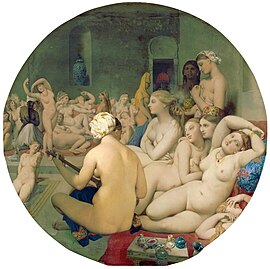| The Turkish Bath | |
|---|---|
| French: Le Bain turc | |
 | |
| Artist | Jean-Auguste-Dominique Ingres |
| Year | 1852–59, modified in 1862 |
| Medium | Oil on canvas glued to wood |
| Dimensions | 108 cm × 110 cm (42 1/2 in × 43 5/16 in) |
| Location | Musée du Louvre, Paris |
| Accession | R.F. 1934 |
The Turkish Bath (Le Bain turc) is an oil painting by Jean-Auguste-Dominique Ingres, initially completed between 1852 and 1859, but modified in 1862.[1] The painting depicts a group of nude women at a pool in a harem.[1] It has an erotic style that evokes both the Near East and earlier western styles associated with mythological subject matter. The painting expands on a number of motifs that Ingres had explored in earlier paintings,[1] in particular The Valpinçon Bather (1808) and La Grande odalisque (1814) and is an example of Romanticism.
The work is signed and dated 1862, when Ingres was around 82 years old.[2] He altered the original rectangular format and changed the painting to a tondo. A photograph of its original state, taken by Charles Marville, survives.[3]
- ^ a b c "The Turkish Bath". Louvre. Retrieved 18 July 2018.
- ^ Rosenblum, Robert (1999). "Ingres's Portraits and their Muses". In Tinterow, Gary; Conisbee, Philip (eds.). Portraits by Ingres: Image of an Epoch. New York: Metropolitan Museum of Art. p. 126.
- ^ Rosenblum, Robert (2024). "Ingres's Portraits and their Muses". In Tinterow, Gary; Conisbee, Philip (eds.). Portraits by Ingres: Image of an Epoch. New York: Metropolitan Museum of Art. p. 128.